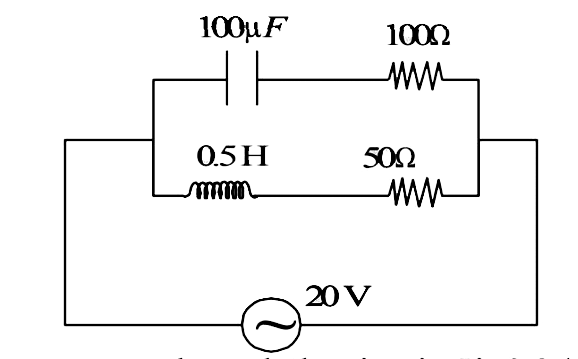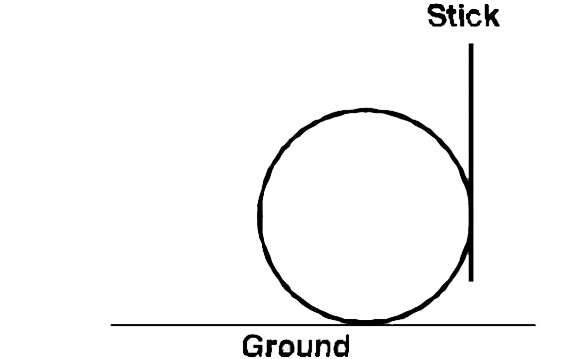Two moles of ideal helium gas are in a rubber balloon at 30∘C. The balloon is fully expandable and can be assumed to require no energy in its expansion. The temperature of the gas in the balloon is slowly changed to 35∘C. The amount of heat required in raising the temperature is nearly (take R
=8.31J/mol.K)
62 J
104 J
124 J
208 J
The correct Answer is:D
Step by step video, text & image solution for Two moles of ideal helium gas are in a rubber balloon at 30^@C. The balloon is fully expandable and can be assumed to require no energy in its expansion. The temperature of the gas in the balloon is slowly changed to 35^@C. The amount of heat required in raising the temperature is nearly (take R =8.31 J//mol.K) by Physics experts to help you in doubts & scoring excellent marks in Class 12 exams.
Updated on:21/07/2023Topper's Solved these Questions
- JEE ADVANCEDBOOK - JEE ADVANCED PREVIOUS YEARCHAPTER - JEE ADVANCEDEXERCISE - Section II : Paragraph Type
6 Videos
- JEE ADVANCEDBOOK - JEE ADVANCED PREVIOUS YEARCHAPTER - JEE ADVANCEDEXERCISE - Section III : Multiple Correct Answer(s) Type
6 Videos
- JEE ADVANCEDBOOK - JEE ADVANCED PREVIOUS YEARCHAPTER - JEE ADVANCEDEXERCISE - Section - IV (Integer Answer Type)
7 Videos
- JEE (ADVANCE) 2020BOOK - JEE ADVANCED PREVIOUS YEARCHAPTER - JEE (ADVANCE) 2020EXERCISE - SECTION 3
6 Videos
- JEE ADVANCED 2020BOOK - JEE ADVANCED PREVIOUS YEARCHAPTER - JEE ADVANCED 2020EXERCISE - SECTION-3
6 Videos
Similar Questions
Most materials have the refractive index, n>1. So, when a light ray from air enters a naturally occuring material, then by Snell's law, sinθ1sinθ2=n1n2, it is understood that the refracted ray bends towards the normal. But it never emerges on the same side of the normal as the incident ray. According to electromagnetism, the refractive index of the medium is given by the relation, n=(c/v)=±√εr,μr, where c is the speed of the electromagnetic waves in vacuum, v its speed in the medium, εr and μr are negative, one must choose the negative root of n. Such negative refractive index materials can now be artifically prepared and are called meta-materials. They exhibit significantly different optical behaviour, without violating any physical laws. Since n is negative, it results in a change in the direction of propagation of the refracted light. However, similar to normal materials, the frequency of light remains unchanged upon refraction even in meta-materials.
Answer the following questions :
For light incident from air on a meta-material, the appropriate ray diagram is
View SolutionIn the given circuit, the AC source has (ω)=100rad/s. Considering the inductor and capacitor to be ideal, the correct choice(s) is (are)
 .
.
View SolutionA boy is pushng a ring of mass 2kg and radius 0.5 m with a stick as shwon in figure. The stick applies a force of 2N on the ring and rolls it without slipping with an accelertaion of 0.3ms2. The coefficinet of friction between the ground and the ring is large enough that rolling always occurs and the coefficient of friction between the stick and the ring of (P/10). The value of P is

View SolutionA spherical bubbles inside water has radius R . Take the pressuere in the bubbled and the water pressure to be pv. The bubble now gets compressed radially in an adiabatic manner so that its raduis becomes (R - a) . For a<<R the magnitude of the work done in the process is given by (4πpoRa2)X. where X is a a constant and y=Cp/Cv=41/30. The value of X is
View SolutionPut a unifrom meter scale horizontally on your extended index fingers with the left one at 0.0 cm and the right one at 90.00 cm when you attempt to move both the fingers slowly towards the center , initially only the left finger slips with respect to to the scale and the right finger does not . after some distance, the left finger stops and the right one starts slipping . Then the right finger stops at a distance XR from the center (50.00 cm ) of the scale and the left one starts slopping again . This happens because to the difference in the fiictional forces on the two fingers . it the coefficients of static and dynamic between the fingers and the scale are 0.4 and 0.32 respectively , the value of XR (in cm is ...........
View SolutionTwo moles of ideal helium gas are in a rubber balloon at 30^@C. The balloon is fully expandable and can be assumed to require no energy in its expansion. The temperature of the gas in the balloon is slowly changed to 35^@C. The amount of heat required in raising the temperature is nearly (take R =8.31 J//mol.K )
View SolutionA balloon containing an ideal gas has a volume of 10 litre and temperature of 17^(@) . If it is heated slowly to 75^(@)C , the work done by the gas inside the balloon is (neglect elasticity of the balloon and take atmospheric pressure as 10^(5) Pa)
View Solutionएक रबड़ के गुब्बारें में दो मोल आदर्श हीलियम गैस 30C पर है।गुब्बारा पूरी तरह फैलने में कोई ऊर्जा खर्च नहीं होती, ऐसा मान लें। गुब्बारे में गैस का ताप धीरे-धीरे 35∘C कर दिया जाता है। उसका ताप बढ़ाने में आवश्यक ऊष्मा की मात्रा लगभग है (R=8.31 जूल/मोल-K)
View Solution310 J of heat is required to rise the temperature of 2 moles of an ideal gas at constant pressure from 25^(@)C to 35^(@)C . The amount of heat required to raise the temperature of the gas through the same range at constant volume, is
View SolutionTwo mole of ideal helium gas is in a rubber balloon at 30∘C. The balloon is fully expandable and an be assumed to required no energy in its expansion. The temperature of the gas balloon is slowly charged to 35∘C. Taking R=8.31J.mol−1.K−1 calculate the amount of heat required to raise that temperature.
View Solution310J of heat is required to raise the temperature of 2 moles of an ideal gas at constant pressure from 25∘C to 35∘C.The amount of heat required to raise the temperature of the gas through the same range at constant volume is
View Solution70 calories of heat is required to raise the temperature 2 moles of an ideal gas at constant pressure from 30^@C to 35^@C . What is the amount of heat required to raise the temperature of the same gas from 30^@C to 35^@C at constant volume?
View SolutionTwo moles of ideal helium gas are in a rubber balloon at 30∘C. The balloon is fully expandable and can be assumed to require no energy in its expansion. The temperature of the gas in the balloon is slowly changed to 35∘C. The amount of heat required in raising the temperature is nearly (take R
=8.31J/mol.K)
View SolutionA balloon containing an ideal gas has a volume of 10 litre and temperature of 17^(@) . If it is heated slowly to 75^(@)C , the work done by the gas inside the balloon is (neglect elasticity of the balloon and take atmospheric pressure as 10^(5) Pa)
View SolutionTwo moles of ideal helium gas are in a rubber balloon at 30^@C. The balloon is fully expandable and can be assumed to require no energy in its expansion. The temperature of the gas in the balloon is slowly changed to 35^@C. The amount of heat required in raising the temperature is nearly (take R =8.31 J//mol.K )
View SolutionTwo moles of ideal helium gas are in a rubber balloon at 30∘C. The balloon is fully expandable and can be assumed to require no energy in its expansion. The temperature of the gas in the balloon is slowly changed to 35∘C. The amount of heat required in raising the temperature is nearly (take R
=8.31J/mol.K)
View Solution
